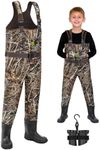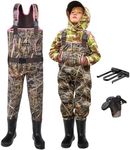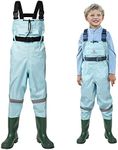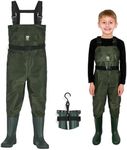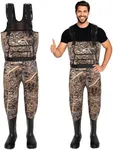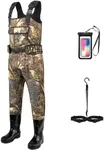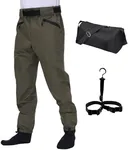Buying Guide for the Best Children Waders
Choosing the right waders for children is essential to ensure they stay dry, comfortable, and safe while enjoying outdoor activities like fishing, playing in streams, or exploring wetlands. When selecting children's waders, it's important to consider several key specifications to find the best fit for your child's needs. Here are the main factors to keep in mind and how to navigate them.MaterialThe material of the waders is crucial because it determines durability, comfort, and waterproofing. Common materials include neoprene, rubber, and breathable fabrics. Neoprene is thick and provides insulation, making it suitable for colder conditions. Rubber is durable and completely waterproof but can be heavy and less comfortable. Breathable fabrics are lightweight and allow moisture to escape, making them ideal for warmer weather. Choose the material based on the typical conditions your child will be in; for colder climates, neoprene is best, while breathable fabrics are better for warmer environments.
Size and FitProper size and fit are essential for comfort and safety. Waders that are too large can be cumbersome and increase the risk of tripping, while waders that are too small can restrict movement and be uncomfortable. Look for waders that offer adjustable straps and belts to ensure a snug fit. Measure your child's height, inseam, and chest to find the right size. It's also a good idea to choose waders with some room for growth, especially if your child is still growing.
Boot TypeWaders come with either built-in boots or stocking feet. Built-in boots are convenient and provide complete waterproof protection, but they can be heavy and less flexible. Stocking foot waders require separate wading boots, which can offer better support and traction but add to the overall cost and complexity. Consider the type of terrain your child will be navigating; built-in boots are great for muddy or wet conditions, while stocking foot waders with separate boots are better for rocky or uneven surfaces.
InsulationInsulation is important if your child will be using the waders in cold water or during cooler weather. Insulated waders, often made from neoprene, provide warmth and are ideal for cold conditions. Non-insulated waders, typically made from breathable fabrics, are better for warmer weather as they prevent overheating. Consider the typical temperature and water conditions your child will encounter to determine the appropriate level of insulation.
DurabilityDurability is key to ensuring the waders last through multiple uses and withstand rough outdoor conditions. Look for reinforced knees and seams, as these areas are prone to wear and tear. High-quality materials and construction will ensure the waders can handle the rigors of outdoor activities. If your child is particularly active or adventurous, investing in more durable waders will be beneficial in the long run.
Safety FeaturesSafety features such as reflective strips, quick-release buckles, and built-in flotation devices can provide added security for your child. Reflective strips enhance visibility in low-light conditions, while quick-release buckles allow for easy removal in case of an emergency. Built-in flotation devices can provide extra buoyancy, which is especially important if your child will be in deeper water. Consider the specific activities and environments your child will be in to determine which safety features are most important.
